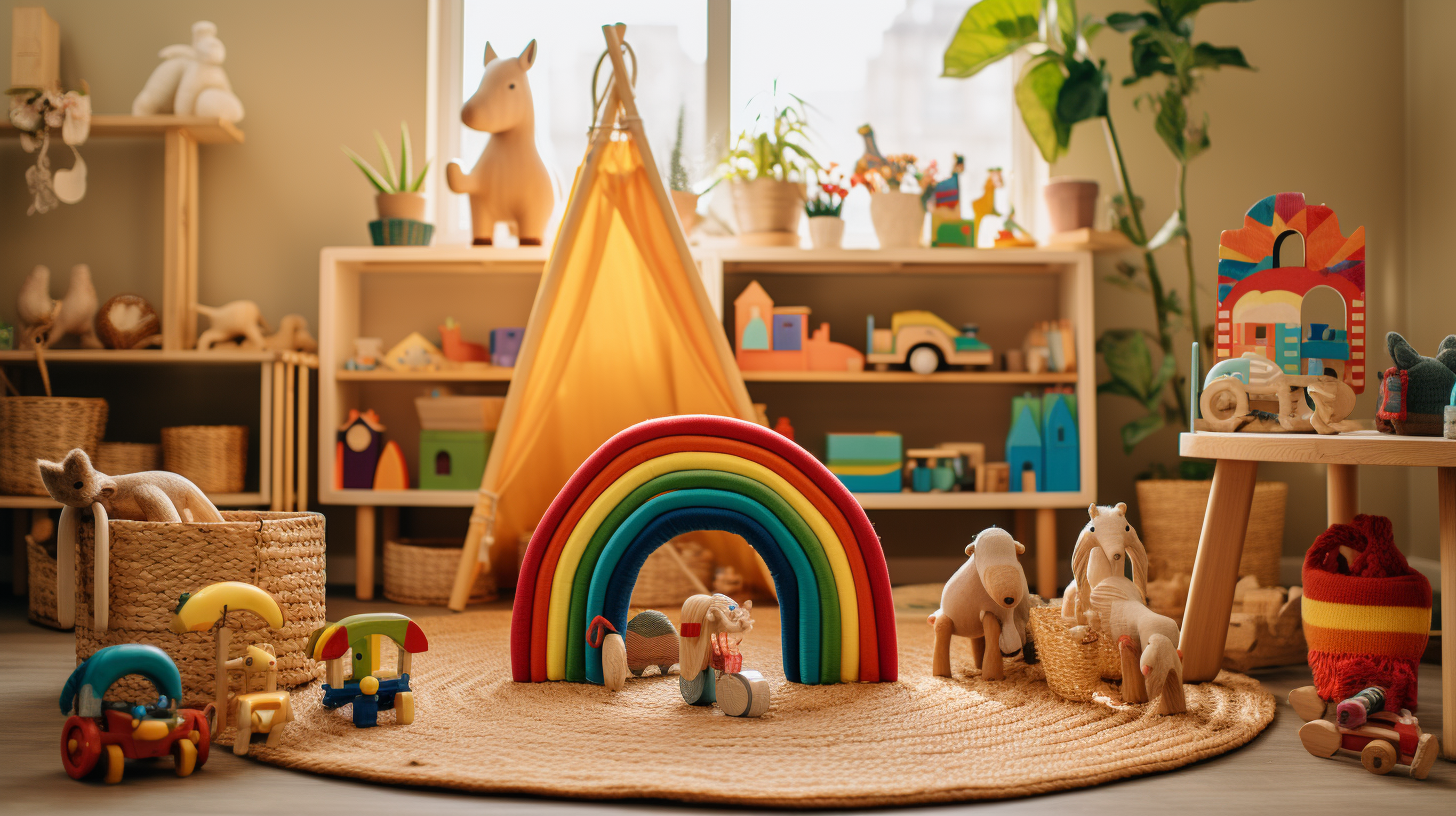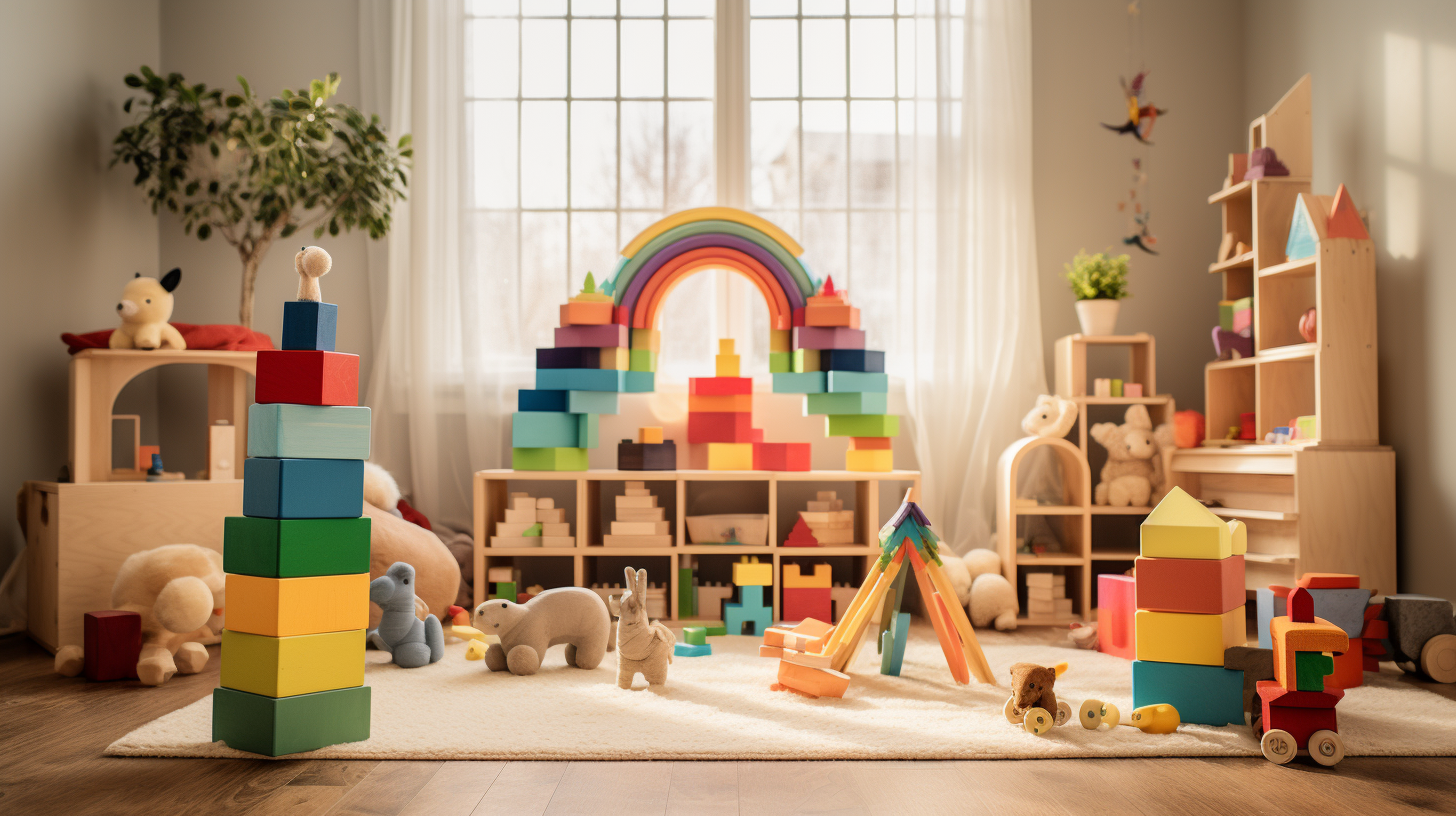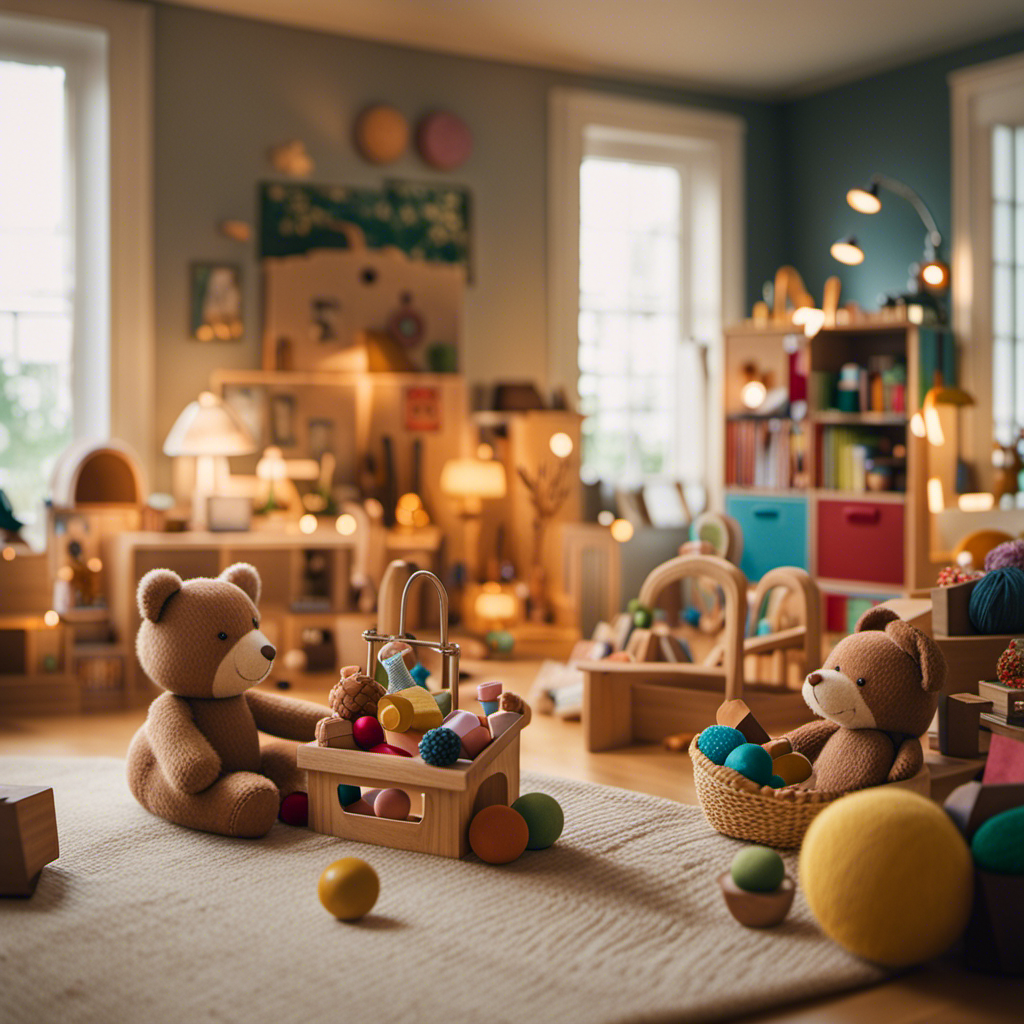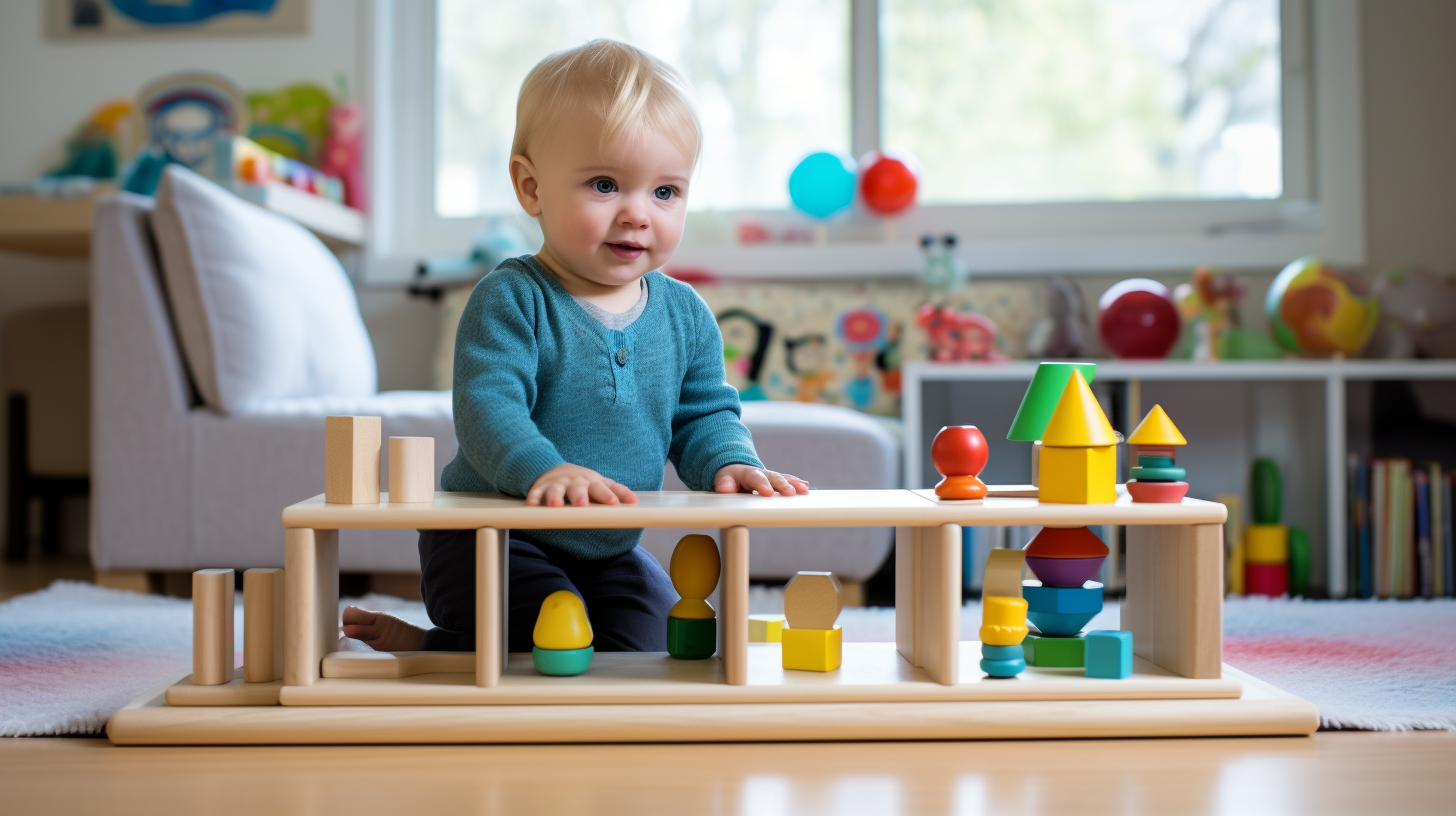As a parent, I am constantly seeking out the best toys to help my child develop. That’s why I am excited to share my discoveries with you about Montessori toys that are especially beneficial in the first year.
These exceptional toys not only promote sensory and cognitive development, but also enhance problem-solving skills and foster independent play.
Join me as we explore the world of Montessori toys, designed to create a foundation of excellence in your child’s first year.
Key Takeaways
- Montessori toys promote sensory and cognitive development
- Choosing appropriate toys is crucial for growth and learning
- Montessori toys enhance problem-solving skills and foster independent play
- Open-ended play with Montessori toys fosters creativity and imagination
The Importance of Montessori Toys in Year One
The importance of Montessori toys in year one can’t be overstated. Choosing appropriate toys for this stage of development is crucial in promoting your child’s growth and learning.
Montessori toys are specifically designed to encourage open-ended play, allowing children to explore and discover at their own pace. These toys provide a range of sensory experiences, from tactile to visual, stimulating their cognitive development.
One of the key benefits of open-ended play is that it fosters creativity and imagination in children, as they are able to use the toys in multiple ways. By engaging with Montessori toys, children develop problem-solving skills, fine motor skills, and spatial awareness.
As we move forward, let’s explore how to choose Montessori toys for your child’s first year, ensuring they have the best tools for optimal growth and development.
How to Choose Montessori Toys for Your Child’s First Year
When choosing toys for your child’s first year, it’s important to consider Montessori principles. Montessori toys are designed to promote independence and foster sensory development in young children.
Here are some key factors to consider when selecting age-appropriate toys for your little one:
- Safety: Ensure that the toys are made of non-toxic materials and have no small parts that could be a choking hazard.
- Open-endedness: Look for toys that can be used in multiple ways and encourage creativity and problem-solving skills.
- Real-life experiences: Choose toys that mimic everyday objects and activities, allowing your child to explore and imitate the world around them.
- Hands-on engagement: Opt for toys that require active manipulation and exploration, promoting fine motor skills and hand-eye coordination.
By choosing toys that align with Montessori principles, you can provide your child with opportunities for independent play and meaningful sensory experiences.
These toys will help lay the foundation for their sensory development in their first year and beyond.
Montessori Toys That Promote Sensory Development in Year One
To promote sensory development in your child’s first year, consider choosing Montessori toys that engage their senses and encourage exploration. Sensory toys provide numerous benefits for your baby’s growth and development, helping them to achieve important developmental milestones. These toys stimulate their senses of sight, hearing, touch, and even taste, allowing them to explore the world around them in a safe and engaging way.
Here is a table showcasing some popular Montessori toys that promote sensory development in year one:
| Toy Name | Sensory Benefits |
|---|---|
| Rattle | Enhances auditory development and hand-eye coordination |
| Sensory Balls | Improves tactile stimulation and fine motor skills |
| Stacking Rings | Encourages visual perception and problem-solving skills |
Fine Motor Skills: Montessori Toys for Year One
As a parent or caregiver, it’s important to understand the benefits that sensory toys can have on a child’s development.
These toys engage a child’s senses, promoting cognitive, physical, and emotional growth.
Sensory Toy Benefits
You’ll love the sensory benefits of these Montessori toys. Sensory play is not only fun, but it also has numerous benefits for your child’s cognitive development. Here are some of the advantages you can expect:
- Visual stimulation: Montessori toys with bright colors and contrasting patterns help stimulate your child’s visual senses, promoting visual tracking and recognition.
- Tactile exploration: Toys with different textures, such as soft fabrics or rough surfaces, encourage your child to explore and develop their sense of touch.
- Hand-eye coordination: Manipulating Montessori toys like stacking blocks or puzzles helps your child improve their hand-eye coordination, as they learn to grasp, manipulate, and place objects.
- Cause and effect: Toys that make sounds or have moving parts teach your child about cause and effect relationships, promoting problem-solving and logical thinking skills.
Developmental Milestones Achieved
As babies reach their first year of life, they start achieving important developmental milestones. These milestones are crucial for their overall growth and development.
One area that undergoes significant progress during this time is gross motor skills. Babies learn to sit up, crawl, and eventually take their first steps. These physical achievements not only strengthen their muscles but also enhance their coordination and balance.
Additionally, cognitive development is a key focus during year one. Babies begin to explore objects and their surroundings with greater curiosity and purpose. They learn cause and effect, start imitating gestures and sounds, and develop problem-solving skills. It is essential to provide them with toys that stimulate their cognitive abilities and encourage exploration.
Now, let’s dive into the world of Montessori toys that are specifically designed to foster cognitive development in year one.
Montessori Toys That Encourage Cognitive Development in Year One
These Montessori toys are designed to foster cognitive development in year one. Montessori toys for sensory exploration provide infants with opportunities to engage their senses and explore the world around them. Examples of these toys include textured balls, sensory bins, and touch and feel books. These toys encourage infants to use their senses of touch, sight, and hearing, helping them to develop their cognitive skills.
Montessori toys for fine motor development focus on strengthening the muscles in the hands and fingers, which are essential for later writing and drawing skills. Toys such as stacking rings, shape sorters, and puzzles help infants practice their hand-eye coordination and develop their problem-solving abilities. As infants interact with these toys, they are building the foundation for their cognitive development in year one.
Moving on to language development, Montessori toys for year one continue to support their growth and progress in communication skills.
Language Development: Montessori Toys for Year One
To support your child’s language development, try using Montessori toys specifically designed for year one. These toys are not only engaging and fun but also promote the development of language skills through play.
Montessori toys for language development include puzzles with letters and pictures, which help children recognize and associate words with their corresponding images. Building blocks with letters and numbers can also enhance vocabulary and numeracy skills. Additionally, interactive toys such as talking dolls or animals can encourage children to imitate sounds and words, fostering their speech and communication abilities.
By providing your child with these Montessori toys, you are creating an environment where language learning becomes a joyful and natural process.
Now, let’s explore Montessori toys to support gross motor skills in year one.
Montessori Toys to Support Gross Motor Skills in Year One
Gross motor skills in year one can be supported by using Montessori toys that encourage physical movement and coordination. As a parent or caregiver, it’s important to provide children with the right toys that promote their physical development.
Here are four Montessori toys that can help enhance gross motor skills in year one:
- Balance Board: A balance board helps children develop their core strength and balance as they rock back and forth or try to stand on it.
- Push Walker: A push walker allows children to practice walking and improve their stability and coordination.
- Large Building Blocks: Building blocks help children develop their hand-eye coordination and fine motor skills as they stack and construct.
- Climbing Triangle: A climbing triangle provides children with opportunities to climb, helping them strengthen their muscles and improve their coordination.
By incorporating these gross motor skills toys into playtime, children can engage in active movement and develop their physical abilities.
Transitioning into the subsequent section about ‘social and emotional development: Montessori toys for year one’, it’s essential to consider toys that support not only physical but also social and emotional growth.
Social and Emotional Development: Montessori Toys for Year One
When choosing Montessori toys for your child’s social and emotional development in year one, consider options that encourage empathy and communication skills. These toys play a crucial role in fostering social interactions and emotional growth in young children. Here are some examples of Montessori toys that can support both social and emotional development in year one:
| Toy Name | Benefits |
|---|---|
| Dollhouse | Encourages role-playing, empathy, and understanding of social dynamics. |
| Puzzles | Promotes problem-solving, patience, and cooperation during play. |
| Musical toys | Enhances self-expression, creativity, and emotional regulation. |
| Stacking toys | Develops fine motor skills, patience, and turn-taking abilities. |
| Play kitchen | Facilitates pretend play, communication, and understanding of routines. |
Montessori Toys for Imaginative Play in Year One
Explore the benefits of incorporating imaginative play with Montessori toys for your child’s development in year one.
Montessori toys are specifically designed to stimulate sensory exploration and encourage imaginative play, both of which are crucial for your child’s cognitive and emotional growth. Here are some reasons why Montessori toys are ideal for promoting imaginative play in year one:
- Montessori toys for sensory exploration:
- Provide a variety of textures, colors, and shapes to engage your child’s senses.
- Enhance fine motor skills through activities like stacking, sorting, and manipulating objects.
- Montessori toys for imaginative play:
- Foster creativity and self-expression by allowing your child to create their own stories and scenarios.
- Encourage role-playing and social interaction, promoting empathy and understanding.
By incorporating Montessori toys into your child’s playtime, you can support their development and foster their imagination.
Now, let’s dive into the next section about Montessori toys for problem-solving in year one.
Montessori Toys for Problem-Solving in Year One
When it comes to problem-solving toys for children in their first year, there are a few key points to consider.
Essential problem-solving toys help develop critical thinking and problem-solving skills from an early age.
The Montessori approach to toys focuses on providing open-ended and hands-on materials that encourage exploration and problem-solving.
Essential Problem-Solving Toys
One essential problem-solving toy is the Rubik’s Cube, which challenges children to think critically and find solutions. It enhances problem-solving skills and improves critical thinking abilities.
Imagine a child’s hands swiftly twisting and turning the colorful cube, their eyes focused on the challenge before them. As they solve the first layer, the feeling of accomplishment washes over them.
With each move, they strategize and analyze, developing their logical reasoning skills. The intricate patterns and rotations of the cube engage their spatial awareness, improving their ability to visualize and manipulate objects in their minds.
The Rubik’s Cube also teaches perseverance and patience. As they encounter obstacles, they learn to adapt and persist until they reach the final solution.
Transitioning into the Montessori approach to toys, fostering problem-solving skills and critical thinking abilities is a cornerstone of this educational philosophy.
Montessori Approach to Toys
Imagine how the Montessori approach to toys can foster your child’s problem-solving skills and critical thinking abilities.
Montessori toys are carefully designed to promote child development through sensory exploration. These toys engage children’s senses and encourage them to explore, manipulate, and learn through hands-on experiences. They provide opportunities for children to develop their fine motor skills, hand-eye coordination, and cognitive abilities.
Montessori toys for sensory exploration include puzzles, shape sorters, stacking toys, and sensory balls. These toys not only entertain children but also stimulate their senses and promote their cognitive development.
The Montessori philosophy emphasizes the importance of providing children with age-appropriate toys that encourage independent play and exploration.
Transitioning into the subsequent section about ‘montessori toys for independent play in year one’, we can explore how these toys further support your child’s development.
Montessori Toys for Independent Play in Year One
There are many Montessori toys available that promote independent play in year one. Independent play is beneficial for young children as it helps develop their problem-solving skills, creativity, and self-confidence.
One recommended Montessori toy for independent play is the shape sorter. This toy allows children to explore different shapes and figure out how to fit them into the corresponding holes.
Another great option is the stacking toy, which helps improve hand-eye coordination and fine motor skills.
Additionally, the object permanence box is an excellent choice as it teaches children about cause and effect and helps develop their understanding of object permanence.
These toys not only provide hours of entertainment but also support a child’s development. Moving on to Montessori toys for outdoor exploration in year one…
Montessori Toys for Outdoor Exploration in Year One
As your little one grows and explores the world, it’s important to provide them with opportunities to connect with nature. Outdoor sensory toys and nature exploration toys are perfect for encouraging your child’s curiosity and love for the great outdoors. These toys not only stimulate their senses but also promote cognitive and physical development.
To help you choose the best toys for outdoor exploration, here’s a table showcasing some popular options:
| Toy Name | Description |
|---|---|
| Sensory Balls | Soft, textured balls that engage touch and motor skills |
| Bug Viewer | Clear container for observing insects up close |
| Nature Scavenger Hunt Kit | A set of cards with nature-themed items to find in the outdoors |
| Butterfly Net | Mesh net for catching and observing butterflies and insects |
| Watering Can | Miniature watering can for teaching responsibility and gardening |
These toys will encourage your child to explore the natural world, fostering a sense of wonder and curiosity. Now, let’s move on to Montessori toys for early math skills in year one.
Montessori Toys for Early Math Skills in Year One
When it comes to early math skills in Year One, two key points to focus on are counting with manipulatives and shape recognition through play.
Counting with manipulatives, such as blocks or counters, allows young children to physically interact with numbers and develop a concrete understanding of quantity.
Shape recognition through play, using toys and activities that involve identifying and matching shapes, helps children build spatial awareness and develop their geometric thinking skills.
Counting With Manipulatives
You can improve your counting skills by using manipulatives. Manipulatives are objects that can be physically manipulated to help children understand mathematical concepts. They are especially effective in developing counting skills and number recognition in Year One children. By using manipulatives, children can actively engage with numbers and develop a concrete understanding of quantity.
One effective way to use manipulatives is through the use of a counting table. Here is an example of a counting table that can be used to aid in number recognition:
| Number | Numeral | Manipulative |
|---|---|---|
| 1 | 1 | ● |
| 2 | 2 | ●● |
| 3 | 3 | ●●● |
| 4 | 4 | ●●●● |
By physically moving the manipulatives and associating them with the corresponding numeral, children can develop a stronger understanding of numbers and counting. This hands-on approach not only enhances their counting skills, but also makes learning more engaging and enjoyable.
Transitioning into the subsequent section about ‘shape recognition through play’, children can further enhance their understanding of mathematical concepts by exploring geometric shapes in a playful manner.
Shape Recognition Through Play
Playing with different shapes can be a fun and interactive way for children to develop their understanding of geometric concepts. Shape recognition is an important skill that lays the foundation for later math and spatial reasoning abilities. Learning through play allows children to engage with shapes in a hands-on and meaningful way.
Shapes provide a sense of accomplishment: Watching a child successfully fit a shape into its corresponding hole can boost their confidence and create a sense of achievement.
Shapes spark creativity: Exploring different shapes can inspire children to think creatively and problem-solve as they manipulate and arrange them.
Building with shapes encourages imagination: Whether it’s constructing a castle or a spaceship, children can use shapes to build their own unique creations.
Overall, incorporating shape recognition into playtime can enhance a child’s cognitive development while providing a fun and engaging learning experience.
Frequently Asked Questions
How Do Montessori Toys Support Sensory Development in Year One?
Montessori toys support sensory development in year one by engaging multiple senses and encouraging exploration. They promote language development through interactive play and problem-solving skills by presenting challenges that require creative thinking and problem-solving strategies.
What Are Some Examples of Montessori Toys That Promote Fine Motor Skills in Year One?
Montessori toys that promote fine motor skills in year one include stacking blocks, peg puzzles, and threading beads. These toys help develop hand-eye coordination and dexterity, essential for tasks like writing and self-care.
How Do Montessori Toys Encourage Cognitive Development in Year One?
Montessori toys promote cognitive development in year one through language development and problem-solving skills. They encourage children to think critically, communicate effectively, and find creative solutions to challenges, laying a strong foundation for future learning.
Can You Recommend Any Montessori Toys That Support Gross Motor Skills in Year One?
Sure, I can recommend Montessori toys that support gross motor skills in year one. They help develop coordination, balance, and strength. Benefits of using Montessori toys for gross motor development in year one are immense.
What Are Some Montessori Toys That Promote Social and Emotional Development in Year One?
Montessori toys that foster social and emotional development in year one are essential. Play is crucial for developing these skills in early childhood. It’s important to choose toys that encourage sharing, empathy, and self-expression.
Conclusion
In conclusion, choosing the right Montessori toys for your child’s first year is crucial for their overall development.
These toys not only promote sensory and cognitive development, but also enhance fine motor skills and problem-solving abilities.
Additionally, they encourage independent play and outdoor exploration, fostering a sense of curiosity and adventure.
Furthermore, early math skills can be nurtured through Montessori toys, setting a solid foundation for future learning.
So, take your time in selecting the perfect Montessori toys for your little one and watch them thrive in their first year of excellence.
Mila, a gifted writer with a heart brimming with enthusiasm for child development and playful learning, is the creative force behind the enchanting narratives and insightful articles that grace Toddler Ride On Toys. With a background in early childhood education and a genuine passion for nurturing young minds, Mila weaves words that captivate, educate, and inspire parents, caregivers, and educators.










